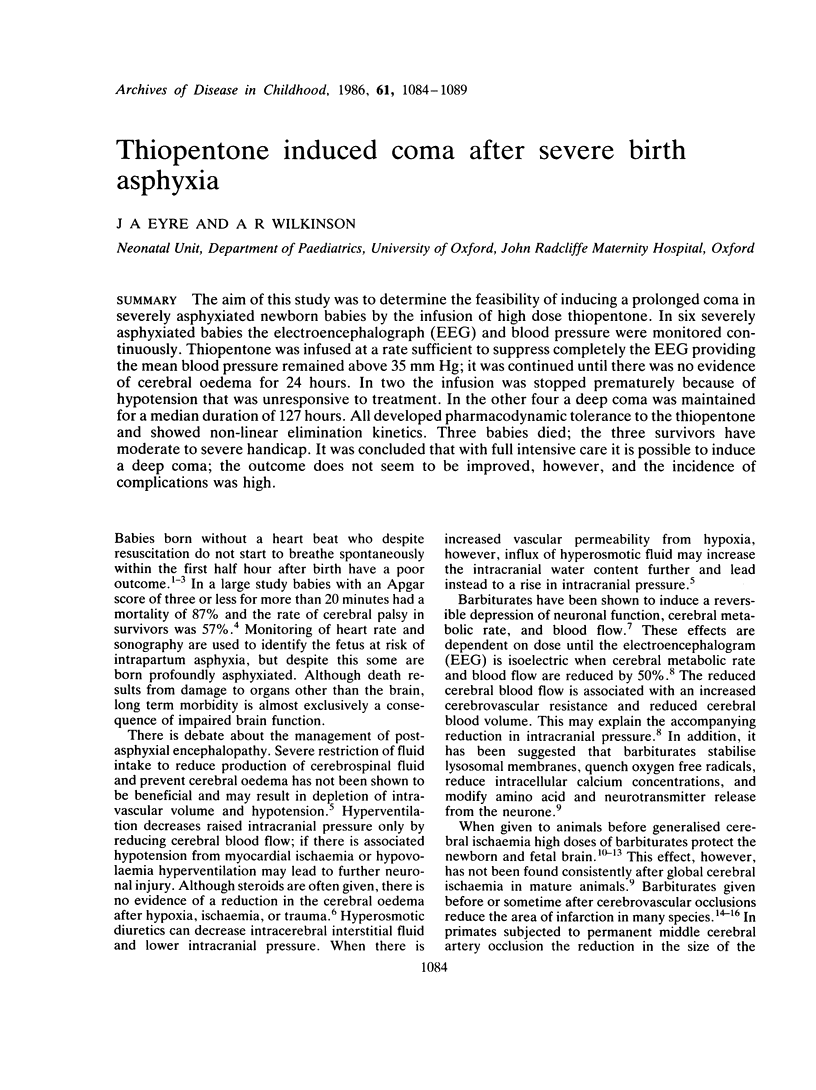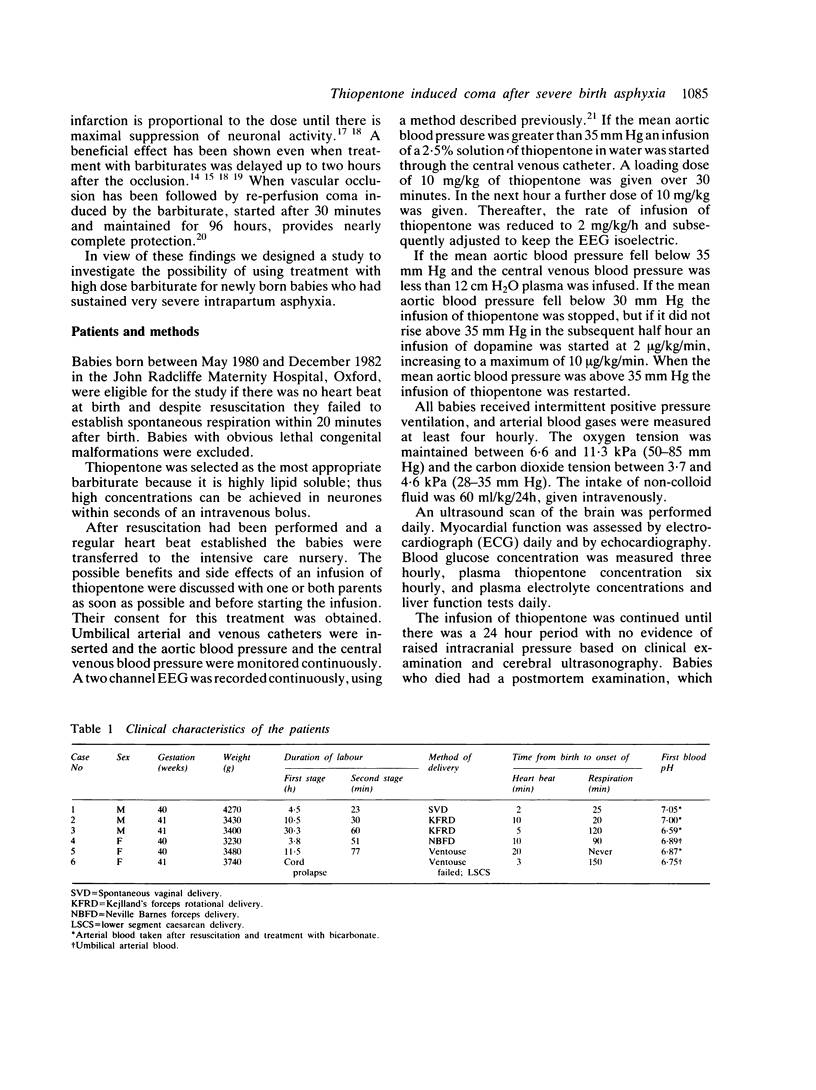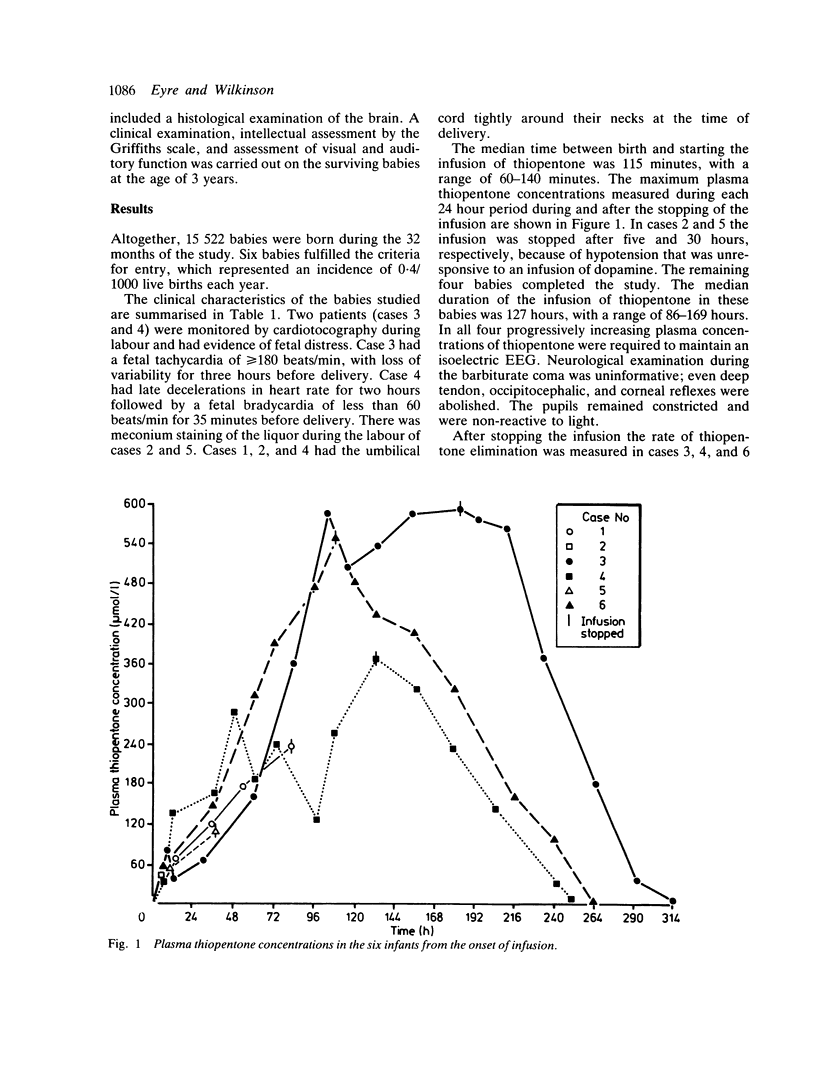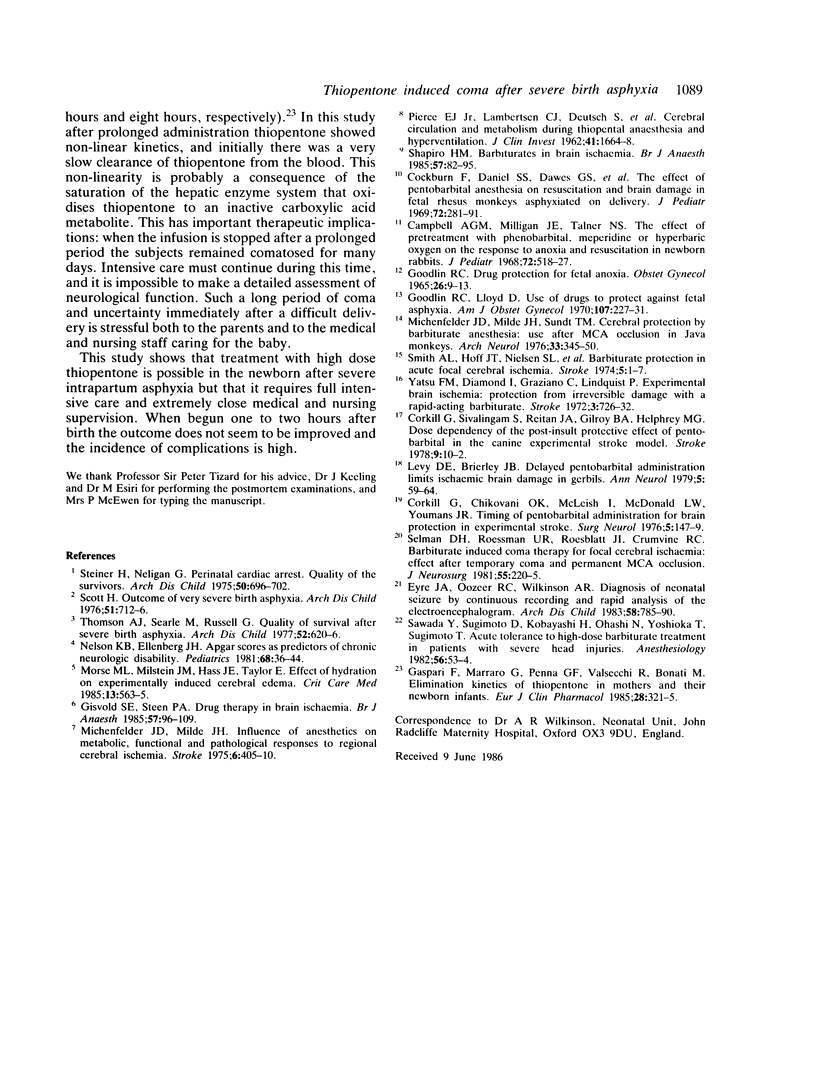Abstract
The aim of this study was to determine the feasibility of inducing a prolonged coma in severely asphyxiated newborn babies by the infusion of high dose thiopentone. In six severely asphyxiated babies the electroencephalograph (EEG) and blood pressure were monitored continuously. Thiopentone was infused at a rate sufficient to suppress completely the EEG providing the mean blood pressure remained above 35 mm Hg; it was continued until there was no evidence of cerebral oedema for 24 hours. In two the infusion was stopped prematurely because of hypotension that was unresponsive to treatment. In the other four a deep coma was maintained for a median duration of 127 hours. All developed pharmacodynamic tolerance to the thiopentone and showed non-linear elimination kinetics. Three babies died; the three survivors have moderate to severe handicap. It was concluded that with full intensive care it is possible to induce a deep coma; the outcome does not seem to be improved, however, and the incidence of complications was high.
Full text
PDF





Selected References
These references are in PubMed. This may not be the complete list of references from this article.
- Campbell A. G., Milligan J. E., Talner N. S. The effect of pretreatment with pentobarbital, meperidine, or hyperbaric oxygen on the response to anoxia and resuscitation in newborn rabbits. J Pediatr. 1968 Apr;72(4):518–527. doi: 10.1016/s0022-3476(68)80343-9. [DOI] [PubMed] [Google Scholar]
- Cockburn F., Daniel S. S., Dawes G. S., James L. S., Myers R. E., Nienann W., Rodriguez de Curet H., Ross B. B. The effect of pentobarbital anesthesia on resuscitation and brain damage in fetal rhesus monkeys asphyxiated on delivery. J Pediatr. 1969 Aug;75(2):281–291. doi: 10.1016/s0022-3476(69)80399-9. [DOI] [PubMed] [Google Scholar]
- Corkill G., Chikovani O. K., McLeish I., McDonald L. W., Youmans J. R. Timing of pentobarbital administration for brain protection in experimental stroke. Surg Neurol. 1976 Mar;5(3):147–149. [PubMed] [Google Scholar]
- Corkill G., Sivalingam S., Reitan J. A., Gilroy B. A., Helphrey M. G. Dose dependency of the post-insult protective effect of pentobarbital in the canine experimental stroke model. Stroke. 1978 Jan-Feb;9(1):10–12. doi: 10.1161/01.str.9.1.10. [DOI] [PubMed] [Google Scholar]
- Eyre J. A., Oozeer R. C., Wilkinson A. R. Diagnosis of neonatal seizure by continuous recording and rapid analysis of the electroencephalogram. Arch Dis Child. 1983 Oct;58(10):785–790. doi: 10.1136/adc.58.10.785. [DOI] [PMC free article] [PubMed] [Google Scholar]
- Gaspari F., Marraro G., Penna G. F., Valsecchi R., Bonati M. Elimination kinetics of thiopentone in mothers and their newborn infants. Eur J Clin Pharmacol. 1985;28(3):321–325. doi: 10.1007/BF00543331. [DOI] [PubMed] [Google Scholar]
- Gisvold S. E., Steen P. A. Drug therapy in brain ischaemia. Br J Anaesth. 1985 Jan;57(1):96–109. doi: 10.1093/bja/57.1.96. [DOI] [PubMed] [Google Scholar]
- Goodlin R. C., Lloyd D. Use of drugs to protect against fetal asphyxia. Am J Obstet Gynecol. 1970 May 15;107(2):227–231. doi: 10.1016/0002-9378(70)90590-9. [DOI] [PubMed] [Google Scholar]
- Levy D. E., Brierley J. B. Delayed pentobarbital administration limits ischemic brain damage in gerbils. Ann Neurol. 1979 Jan;5(1):59–64. doi: 10.1002/ana.410050109. [DOI] [PubMed] [Google Scholar]
- Michenfelder J. D., Milde J. H. Influence of anesthetics on metabolic, functional and pathological responses to regional cerebral ischemia. Stroke. 1975 Jul-Aug;6(4):405–410. doi: 10.1161/01.str.6.4.405. [DOI] [PubMed] [Google Scholar]
- Michenfelder J. D., Milde J. H., Sundt T. M., Jr Cerebral protection by barbiturate anesthesia. Use after middle cerebral artery occlusion in Java monkeys. Arch Neurol. 1976 May;33(5):345–350. doi: 10.1001/archneur.1976.00500050031006. [DOI] [PubMed] [Google Scholar]
- Morse M. L., Milstein J. M., Haas J. E., Taylor E. Effect of hydration on experimentally induced cerebral edema. Crit Care Med. 1985 Jul;13(7):563–565. doi: 10.1097/00003246-198507000-00011. [DOI] [PubMed] [Google Scholar]
- Nelson K. B., Ellenberg J. H. Apgar scores as predictors of chronic neurologic disability. Pediatrics. 1981 Jul;68(1):36–44. [PubMed] [Google Scholar]
- PIERCE E. C., Jr, LAMBERTSEN C. J., DEUTSCH S., CHASE P. E., LINDE H. W., DRIPPS R. D., PRICE H. L. Cerebral circulation and metabolism during thiopental anesthesia and hyper-ventilation in man. J Clin Invest. 1962 Aug;41:1664–1671. doi: 10.1172/JCI104623. [DOI] [PMC free article] [PubMed] [Google Scholar]
- Sawada Y., Sugimoto H., Kobayashi H., Ohashi N., Yoshioka T., Sugimoto T. Acute tolerance to high-dose barbiturate treatment in patients with severe head injuries. Anesthesiology. 1982 Jan;56(1):53–54. doi: 10.1097/00000542-198201000-00013. [DOI] [PubMed] [Google Scholar]
- Scott H. Outcome of very severe birth asphyxia. Arch Dis Child. 1976 Sep;51(9):712–716. doi: 10.1136/adc.51.9.712. [DOI] [PMC free article] [PubMed] [Google Scholar]
- Selman W. R., Spetzler R. F., Roessmann U. R., Rosenblatt J. I., Crumrine R. C. Barbiturate-induced coma therapy for focal cerebral ischemia. Effect after temporary and permanent MCA occlusion. J Neurosurg. 1981 Aug;55(2):220–226. doi: 10.3171/jns.1981.55.2.0220. [DOI] [PubMed] [Google Scholar]
- Shapiro H. M. Barbiturates in brain ischaemia. Br J Anaesth. 1985 Jan;57(1):82–95. doi: 10.1093/bja/57.1.82. [DOI] [PubMed] [Google Scholar]
- Smith A. L., Hoff J. T., Nielsen S. L., Larson C. P. Barbiturate protection in acute focal cerebral ischemia. Stroke. 1974 Jan-Feb;5(1):1–7. doi: 10.1161/01.str.5.1.1. [DOI] [PubMed] [Google Scholar]
- Steiner H., Neligan G. Perinatal cardiac arrest. Quality of the survivors. Arch Dis Child. 1975 Sep;50(9):696–702. doi: 10.1136/adc.50.9.696. [DOI] [PMC free article] [PubMed] [Google Scholar]
- Thomson A. J., Searle M., Russell G. Quality of survival after severe birth asphyxia. Arch Dis Child. 1977 Aug;52(8):620–626. doi: 10.1136/adc.52.8.620. [DOI] [PMC free article] [PubMed] [Google Scholar]
- Yatsu F. M., Diamond I., Graziano C., Lindquist P. Experimental brain ischemia: protection from irreversible damage with a rapid-acting barbiturate (methohexital). Stroke. 1972 Nov-Dec;3(6):726–732. doi: 10.1161/01.str.3.6.726. [DOI] [PubMed] [Google Scholar]


